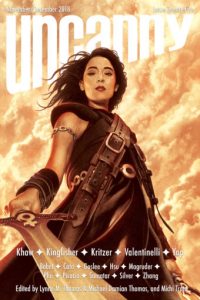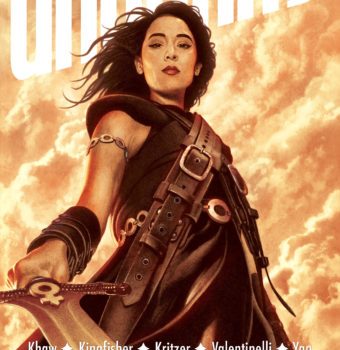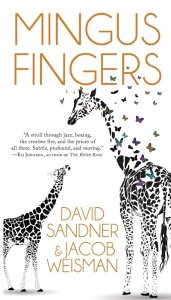Paula Guran Reviews Short Fiction: Uncanny, Shimmer, Nightmare, Apex, and The Dark
 Uncanny 11-12/18
Uncanny 11-12/18
Shimmer 11/18
Nightmare 1/19
Apex 11/18, 12/18
The Dark 12/18
Not all of the stories in Uncanny #25 are dark, but – oh well. The standout story for #25 is Naomi Kritzer‘s novelette “The Thing About Ghost Stories“. Leah’s doctoral dissertation is on the meaning of ghost stories. She gains an academic position just as her mother is descending into dementia. After the mother’s death, Leah again has time for research. Using this interesting framework, Kritzer explores loss and belief. It’s a touching tale I quite enjoyed
“How to Swallow the Moon” by Isabel Yap is a love story crossed with a fairy tale. Anyag is a binukot, a girl kept away from the world to enhance her value as a bride. Amira is Anyag’s servant, but also her dearest friend, caregiver, and protector. She’s also in love with Anyag. Male suitors arrive one after another and Amira suffers in silence. It turns out Anyang feels the same way about Amira. Complications arise. Both young women must be heroic. Connections to Philippine mythology freshen this well-told tale.
Cassandra Khaw‘s short “Monologue by an unnamed mage, recorded at the brink of the end” is what it says it is. The world is ending, but love lives on and this mage declaims prettily about it. I suspect readers with stars in their eyes will enjoy it more than those of us whose optical organs are burned out by cynicism.
In T. Kingfisher‘s lusty “The Rose MacGregor Drinking and Admiration Society“, the title character is an ardent young women who turns the love-’em-and-leave-’em tables on various faerie boys. Amusing but nonessential.
Even cyborgs have their #MeToo moment in Monica Valentinelli‘s “My Name Is Cybernetic Model XR389F, and I Am Beautiful“. Senior Engineer Robert Brandt programs a cyborg to initiate autonomous romantic human behavior with another cyborg – XR389F. You can’t miss the point – sexual harassment in the workplace will evidently never die – but overall the story misses the mark.
Nightmare #76 ushers in 2019 with two suitably dark offerings. In Natalia Theodoridou‘s “What It Sounds Like When You Fall“, folks are put into their graves before they die. There are angels on Earth, but they are far from the superior spiritual beings one might expect: they are as pesky as pigeons and not much more intelligent. The government encourages killing them. Still, if you are good to the angels, they can give you valuables – or, just as likely, useless trinkets. There’s a hint that gainful employment is somehow redemptive. Theodoridou leaves the reader with more questions than answers and more mood than story, but, nevertheless, manages to fascinate and impress
Vajra Chandrasekera‘s darkly fantastic “On the Origin of Specie” may inspire you to make sure you give the IRS its due. The nameless narrator’s punishment for refusing to pay war-supporting taxes is to be cast into a hole that is both endless and isolating. Chandrasekera’s visceral description of this punishment is suffocating and so is the rhetoric the narrator recalls spouting in protest. Life, this story convinces, is indeed hell.
Three new stories for Apex #114.
“Master Brahms” by Storm Humbert: In an AI-run house full of clones (called “synths”) – all named Brahms – there is a murder. Or is it a suicide, since Brahms has killed Brahms? The AI has been tampered with, so there’s no immediate way to determine who is the original Brahms. To call the police would endanger all the clone Brahmses: synths possess “no legal personage when it came to a conflict with their original” and if one is found guilty of murder, they would probably all be destroyed. At this point, I wish Sherlock Holmes or Hercule Poirot had entered to dazzle with a cerebral solution to the crime. Humbert, however, poses the problem and answers it by playing with the narrator’s conviction that he is the true Brahms. Surely there is a way to determine – without law enforcement, outside the walls of the house, and despite a hacked AI – who the original is? Evidently not, as no one resorts to it. That may be the point, but I wanted to be dazzled.
Gary A. Braunbeck‘s “Godzilla vs. Buster Keaton or: I Didn’t Even Need a Map” is an elegiac novelette focusing on grief and memory, overcoming guilt, and the importance of living life well. Oh, and cognitive dissonance. Ultimately Glenn, who has lost his sister, is urged to “(b)ecome part of the world, even if you have to make a fool of yourself to do it….” In doing so, he is seen as a threat and is sure to suffer legal consequences as a result. This is probably not the impression Braunbeck wishes to leave with the reader, but it is the one I came away with. Maybe becoming part of the world isn’t really worth it.
Magic, both official and un-, is used to survive in the dire, urban, climate-changed near future of “Toward a New Lexicon of Augury” by Sabrina Vourvoulias. Among the unofficial are the Mole Street Mob: “Witches extraordinaire, dark women running a dark market.” The municipal powers that be are (as always) intent on “improving” the Mob’s neighborhood out of existence. The narrator – an augurer whose powers are not the strongest – becomes central to a plot to foil it. The entertaining story is complete in itself – a rapid-read 7,000 words – but the rich characterizations and premise would lend themselves to a longer work. In this case, being left wanting more is a compliment.
And three more from Apex #115.
“On the Day You Spend Forever with Your Dog” by Adam R. Shannon is a moving story about love (for a pet) and death and grief and the inevitability of time (and maybe responsibility). Shannon uses time travel to explore his themes: a unique use of the trope. It is hard to judge a cyclical and emotional story like this. Effective for me, but possibly irritating for you.
In A.C. Buchanan‘s “Girls Who Do Not Drown“, 15-year-old Alice “looks every bit the boy she isn’t.” She lives and suffers in a town the author very much wants you to see as a place that fates its girls to either doom (glashtyn, a sort of sea kelpie, will drown them) or dooming circumscription (stereotypical domestic life) and where Alice’s ability to survive despite being “different” ultimately shows the other girls they too can escape predestined fate. Except, to me, the metaphor is flawed. There are, according to the story, always girls who escape fate and Alice’s belief that no one knows she is a girl is disproved by the glashtyn’s recognition.
The titular character in “Captain Midrise” by James Marino is “stuck at one altitude, drifting along around the level of a sixth-story window” and there are other indications that he’s not the superhero he once was. The narrator, a reporter, searches for answers, finally talking to the captain himself, whose answer may be practical, philosophical, metaphysical, or even religious. Clever, maybe insightful, it’s worth a read.
As I mentioned a couple of months ago, Shimmer is ceasing publication. Shimmer #46, the final issue, offers a dozen stories – about triple the usual number. Unfortunately, most of them fall under the category of “interesting premise, but incomplete execution; needs revision.” Fortunately, three are standouts.
“Rotkäppchen” by Emily McCosh: Adeline, once known as Red Riding Hood, is a grandmother now, grieving for her husband and, most recently, her son – killed by a seemingly invincible bear. She is comforted by her old friend the wolf. The time of fairy tales has passed: “People are not so ready to believe in magic as they once were. There aren’t many around who will remember a time when you could strike a friendship with a wolf.” Despite the dangers of the wood, the vicissitudes of age, and the certainty of death, there is still enough transformative magic left in the world for Adeline and her granddaughter. McCosh has gently and memorably crafted a subverted fairy tale that manages to comfort as well as confront.
“The Time Traveler’s Husband” by A.C. Wise is something of a literary response to Audrey Niffinegger’s novel The Time Traveler’s Wife. Wise’s characters have a fuller – if challenging – relationship and a truer romance. Niffinegger’s woman protagonist – groomed from childhood by her future husband to be his Stepford wife – is confined to passively and faithfully waiting for him to show up; her counterpart in Wise’s story is the adventurer. Nor does Wise’s time traveler seem to be as guiltless and irresponsible as Niffinegger’s character. Readers need not be acquainted with the novel to enjoy the short story. It stands poignantly and effectively on its own.
“Rust and Bone” by Mary Robinette Kowal: A surreal fairy tale of vivid images both dreamlike and nightmarish that, despite its intentional unreality, conveys a timeless sense of danger and love. Brilliant.
Finally, The Dark‘s last issue of 2018 consists of four original stories rather than the usual two new/two reprints. A quintet of truly stygian holiday non-cheer.
I tried really hard to accept “Russula’s Wake” by Kay Chronister as a good creepy story about not-exactly-human offspring loved by an all-too-human mother. Chronister’s characters – Jane, the mother, and her three children are effectively drawn. If the reader can overlook what I see as a shortcoming of the premise – how can Jane think that anything but isolation is necessary to her strange children’s survival? – and I suspect they will, then “Russula’s Wake” will provide an them with an eerie journey.
In “Walking Off the Doeskin” by Wenmimareba Klobah Collins, dead Jane emerges from her grave and soon meets others like herself. Disquietude grows, but with the revelation of truth, moody unease is suddenly replaced by horror. Vengeance is wreaked. As Stephen King famously wrote, “I recognize terror as the finest emotion and so I will try to terrorize the reader. But if I find that I cannot terrify, I will try to horrify, and if I find that I cannot horrify, I’ll go for the gross-out. I’m not proud.” It would have been nice if Collins could have continued terrorizing.
Ruth EJ Booth‘s “Telling Stories” is, I think, a story about the stories we tell ourselves about our relationships. Or maybe just this single relationship. Or maybe how much truth or reality one can share. Or bear. Anyway, it is all experimental-ish, with some beautiful writing and splendid imagery. You will also learn a new word: cuil, which (although the story doesn’t say so) is derived from a Gaelic word meaning knowledge.
Translated from Spanish by David Bowles, “Art” is by Alberto Chimal, a notable Mexican writer. The world ends and the story ponders the last two folks to die. It’s a fancy meta way of messing about with the old We Are but Cosmic Playthings trope – in this case, we are a sort of über-art project coming to an end we, of course, cannot appreciate.
Complete annihilation and acknowledgement of the meaninglessness of life is, I guess as good a way to end the year as any!
Paula Guran has edited more than 40 science fiction, fantasy, and horror anthologies and more than 50 novels and collections featuring the same. She’s reviewed and written articles for dozens of publications. She lives in Akron, Ohio, near enough to her grandchildren to frequently be indulgent.
This review and more like it in the February 2019 issue of Locus.
 While you are here, please take a moment to support Locus with a one-time or recurring donation. We rely on reader donations to keep the magazine and site going, and would like to keep the site paywall free, but WE NEED YOUR FINANCIAL SUPPORT to continue quality coverage of the science fiction and fantasy field.
While you are here, please take a moment to support Locus with a one-time or recurring donation. We rely on reader donations to keep the magazine and site going, and would like to keep the site paywall free, but WE NEED YOUR FINANCIAL SUPPORT to continue quality coverage of the science fiction and fantasy field.







